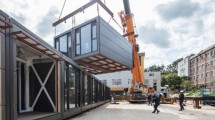Abstract
The general computer-aided design (CAD) software cannot meet the mould design requirement of the autoclave process for composites, because many parameters such as temperature and pressure should be considered in the mould design process, in addition to the material and geometry of the part. A framed-mould computer-aided design system (FMCAD) used in the autoclave moulding process is proposed in this paper. A function model of the software is presented, in which influence factors such as part structure, mould structure, and process parameters are considered; a design model of the software is established using object oriented (O-O) technology to integrate the stiffness calculation, temperature field calculation, and deformation field calculation of mould in the design, and in the design model, a hybrid model of mould based on calculation feature and form feature is presented to support those calculations. A prototype system is developed, in which a mould design process wizard is built to integrate the input information, calculation, analysis, data storage, display, and design results of mould design. Finally, three design examples are used to verify the prototype.
Similar content being viewed by others
References
D. C. Blest, S. McKee, A. K. Zulkie, P. Marshall. Curing simulation by autoclave resin infusion. Composites Science and Technology, vol. 59, no. 16, pp. 2297–2313, 1999.
R. De Oliveira, S. Lavanchy, R. Chatton, D. Costantini, V. Michaud, R. Salathé. Experimental investigation of the effect of the mould thermal expansion on the development of internal stresses during carbon fibre composite processing. Composites Part A: Applied Science and Manufacturing, vol. 39, no. 7, pp. 1083–1090, 2008.
C. H. Chu, M. C. Song, V. Luo. Computer aided parametric design for 3D tire mold production. Computers in Industry, vol. 57, no. 1, pp. 11–25, 2006.
M. W. Fu. The application of surface demoldability and moldability to side-core design in die and mold CAD. Computer-aided Design, vol. 40, no. 5, pp. 567–575, 2008.
K. W. Tam, K. W. Chan. Thermoforming mould design using a reverse engineering approach. Robotics and Computer-integrated Manufacturing, vol. 23, no. 3, pp. 305–314, 2007.
Z. Lou, H. Jiang, X. Ruan. Development of an integrated knowledge-based system for mould-base design. Journal of Materials Processing Technology, vol. 150, no. 1-2, pp. 194–199, 2004.
Y. S. Ma, S. B. Tor, G. A. Britton. The development of a standard component library for plastic injection mould design using an object-oriented approach. International Journal of Advanced Manufacturing Technology, vol. 22, no. 9–10, pp. 611–618, 2003.
C. K. Mok, K. S. Chin, H. B. Lan. An Internet-based intelligent design system for injection moulds. Robotics and Computer-integrated Manufacturing, vol. 24, no. 1, pp. 1–15, 2008.
K. Nagahanumaiah, B. Ravi. Computer aided rapid tooling process selection and manufacturability evaluation for injection mold development. Computers in Industry, vol. 59, no. 2–3, pp. 262–276, 2008.
Z. Zhao, J. J. Shah. Domain independent shell for DfM and its application to sheet metal forming and injection molding. Computer-aided Design, vol. 37, no. 9, pp. 881–898, 2005.
S. H. Tang, Y. M. Kong, S. M. Spapuan, R. Samin, S. Sulaiman. Design and thermal analysis of plastic injection mould. Journal of Materials Processing Technology, vol. 171, no. 2, pp. 259–267, 2006.
A. Bendada, A. Derdouri, M. Lamontagne, Y. Simard. Analysis of thermal contact resistance between polymer and mould in injection moulding. Applied Thermal Engineering, vol. 24, no. 14–15, pp. 2029–2040, 2004.
G. Q. Yue, B. M. Zhang, S. Y. Du, F. H. Dai, C. Zhang, X. Z. Liang, Y. G. Wang. Geometrical deformations of the framed-mould in autoclave processing for composite structures. Acta Materiae Compositae Sinica, vol. 26, no. 5, pp. 148–152, 2009. (in Chinese)
S. H. Lee. A CAD-CAE integration approach using featurebased multi-resolution and multi-abstraction modeling techniques. Computer-aided Design, vol. 37, no. 9, pp. 941–955, 2005.
C. Zhang. Curing temperature field tradeoff design method of large-scale composite material structure in autoclave process, Ph.D. dissertation, Harbin Institute of Technology, PRC, 2009. (in Chinese)
Author information
Authors and Affiliations
Corresponding author
Additional information
Tian-Guo Jin received the B. Sc. degree in precision instruments in 1991, the M. Sc. degree in mechanical-electronic engineering in 1997, and the Ph.D. degree in mechanical-electronic engineering in 2001, all from the Harbin Institute of Technology, PRC. Currently, he is an associate professor at Harbin Institute of Technology.
His research interests include CAD/CAM, enterprise resource planning (ERP), and composites material form processing.
Feng-Yang Bi received the M. Sc. degree in material engineering from the Harbin Engineering University, PRC in 2006. Now, he is a Ph. D. candidate in mechanical-electronic engineering from Harbin Institute of Technology, PRC, and at the same time he is a lecturer at Heilongjiang Institute of Technology, PRC.
His research interests include CAD/CAM and material form processing.
Rights and permissions
About this article
Cite this article
Jin, TG., Bi, FY. A computer-aided design system for framed-mould in autoclave processing. Int. J. Autom. Comput. 7, 261–270 (2010). https://doi.org/10.1007/s11633-010-0501-0
Received:
Revised:
Published:
Issue Date:
DOI: https://doi.org/10.1007/s11633-010-0501-0




